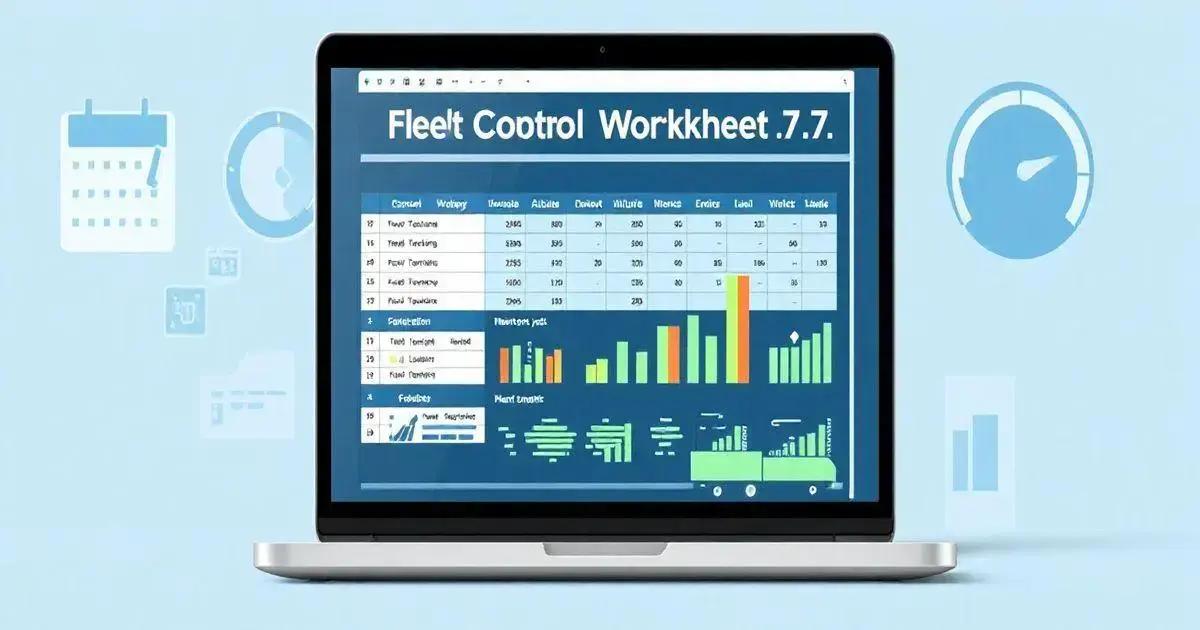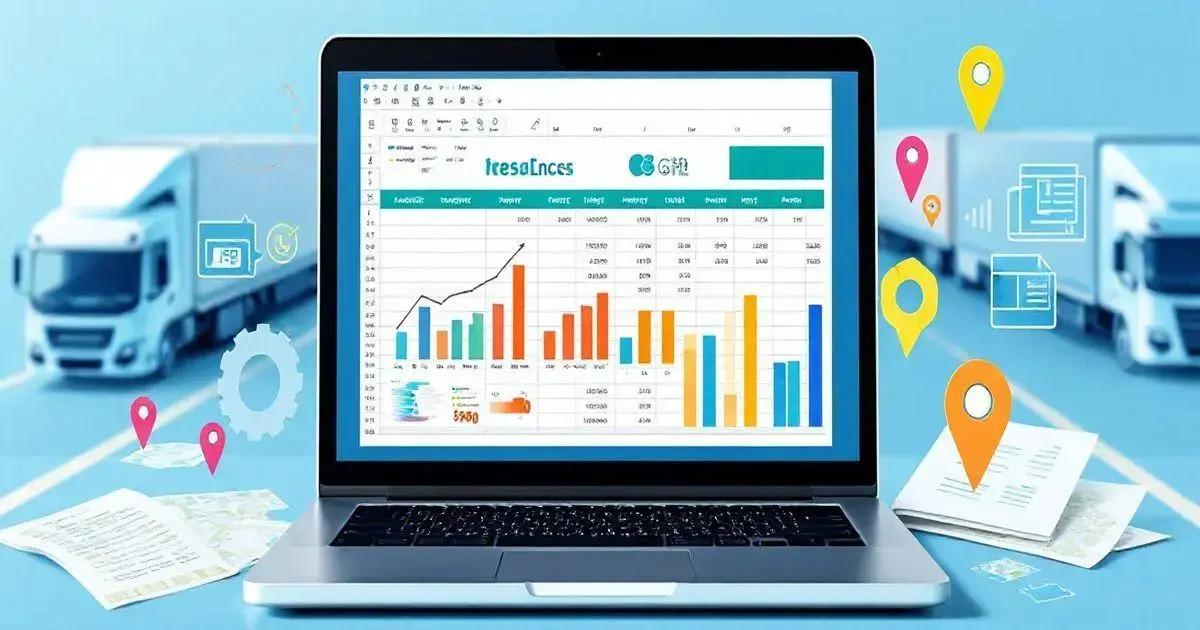Maximize Efficiency with Fleet Control Worksheet 7.0 Leave a comment
The Fleet Control Worksheet 7.0 is an essential tool for fleet managers, offering features like travel control, tire management, maintenance tracking, and document management. It helps monitor key metrics such as kilometers driven, fuel consumption, and maintenance costs, while promoting preventive maintenance to minimize breakdowns. By maintaining detailed records of drivers and vehicles, it enhances compliance and operational efficiency, leading to informed decision-making and cost savings.
The Fleet Control Worksheet 7.0 is designed to streamline your fleet management process. This comprehensive tool allows you to monitor various aspects of your fleet, from travel and cargo control to maintenance schedules and fuel consumption tracking.
In this article, we will uncover how this innovative spreadsheet can revolutionize your fleet’s operational efficiency and help you make informed decisions.
Initial Dashboards
The Fleet Control Worksheet 7.0 offers an array of insightful initial dashboards that provide a comprehensive overview of your fleet’s performance. Here are the key metrics you can track:
- KM by Driver: This metric allows you to evaluate the distance each driver covers, helping you identify high-performing drivers as well as those who may need additional training.
- KM per Vehicle: Understanding how much each vehicle is used helps optimize assigning vehicles to drivers based on their efficiency and needs.
- KM per Liter: This vital metric calculates fuel efficiency, allowing you to pinpoint which vehicles may be consuming more fuel than necessary.
- KM per Trip: Analyze the distance traveled for each trip to assess route efficiency and identify potential areas for optimization.
- Average Consumption per Vehicle: This displays average fuel consumption rates, aiding in budget forecasting and maintaining operational costs effectively.
- Average Consumption per Driver: Track fuel efficiency on a per-driver basis, which can help in rewarding efficient drivers and addressing poor practices.
- Total General, Preventive and Corrective Maintenance: An overview of all maintenance activities helps ensure vehicles are well-maintained, reducing the risks of breakdowns.
- Maintenance Cost Average: Stay informed about the average costs of maintenance, allowing for better budget management and cost reduction strategies.
- Total cost of Mechanical and Electrical Maintenance: Monitor costs associated with mechanical and electrical repairs to manage financial resources effectively.
- Total Tire Maintenance Cost: Keep track of expenses related to tire maintenance to help make timely replacements and manage costs efficiently.
- Total Lubricant Cost: Understanding lubricant expenses helps keep your fleet in optimal condition while managing operational costs.
- Average cost of Mechanical and Electrical Maintenance: Evaluate average expenditures on repairs to identify any unusual costs.
- Average Tire Maintenance Cost: Assess the general tire maintenance costs over time to help inform purchasing decisions.
- Average cost with Lubricants: Analyze lubricant costs across the fleet for improved budgeting.
- Vehicles in Transit: Keep an eye on which vehicles are currently on the road, ensuring effective resource allocation and planning.
- Tires in Transit: Monitor tire conditions to ensure safety and compliance with maintenance schedules.
- Delayed Vehicle Documents: Track any delays in obtaining important vehicle documentation to avoid legal complications.
- Delayed Driver Documents: Ensure all driver documentation is up to date and address any issues proactively.
- Delayed Preventive Maintenance: Stay informed about any overdue maintenance to maintain safety and vehicle performance.
- Total Cost Versus Shipping: Compare total operational costs against shipping income to assess profitability.
- Fuel, Maintenance and Other Costs: Combine all these factors to get a rounded view of your fleet’s operational costs, enabling better financial planning.
These dashboards not only provide crucial insights but also help fleet managers make data-driven decisions, fostering efficiency and cost savings. By regularly monitoring these metrics, you position your fleet for long-term success.

Registrations
Effective fleet management requires meticulous record-keeping, and the Fleet Control Worksheet 7.0 excels in this area by providing dedicated sections for various registrations crucial for your fleet operations. Here’s what you can track:
Registrations
- Driver Registration: Capture essential details about each driver, including license information, contact details, and training certifications. This helps ensure compliance and reduces liability risks.
- Vehicle Type Registration: Keep a comprehensive record of each vehicle in your fleet along with its specifications, such as make, model, year, and capacity. This information is vital for maintenance planning and budgeting.
- Mechanical and Electrical Services Registry: Document all services performed on each vehicle, including routine maintenance and repairs. This registry aids in tracking service history and aids in forecasting future maintenance needs.
- Tree Service Registration: If your fleet includes specialized vehicles for tree services, this section allows you to keep track of the specific equipment and services related to those vehicles.
- Lubricant Services Register: Maintain a log of lubricant services provided to each vehicle, ensuring that they receive the right products at the right intervals to enhance performance and longevity.
- Register of Workshops and Suppliers: Keep contact information and details for all workshops and suppliers used for servicing and repairs. This facilitates quicker communication and service turnaround when needed.
- Expenditure Type Register: Categorize all expenditures related to fleet operations, such as fuel, maintenance, and repairs. This helps in budgeting and financial analysis.
- Refueling Station Registration: Document the refueling stations used by your fleet to manage fuel cards and monitor fuel expenditure effectively.
- Fuel Type Register: Keep track of the types of fuel used by different vehicles, which is essential for compliance and efficient resource allocation.
By maintaining detailed registrations for drivers, vehicles, and services, the Fleet Control Worksheet 7.0 equips fleet managers with the tools needed for efficient management and strategic planning. Proper record-keeping not only enhances transparency but also allows for better decision-making and optimization of resources.
Document Management
Efficient document management is vital for maintaining compliance and ensuring that all necessary paperwork is organized and accessible. The Fleet Control Worksheet 7.0 includes a specialized section dedicated to document management, allowing fleet managers to keep track of important documents related to both drivers and vehicles. Here’s what you can manage:
Document Management
- Driver Document Control: Maintain a comprehensive registry of all documents associated with each driver. This includes licenses, certifications, insurance papers, and any other essential documentation needed for operational compliance. Having this information at your fingertips minimizes the risk of oversight or lapses in compliance.
- Vehicle Document Control: Similarly, this section tracks all documents related to each vehicle in your fleet. This encompasses registration papers, insurance documents, inspection records, and service histories. Centralizing this information helps streamline processes and ensures that all vehicles are compliant with local regulations.
By utilizing the document management capabilities of the Fleet Control Worksheet 7.0, fleet managers can ensure that all necessary documents are current and readily accessible. This not only aids in smooth operations but also protects the organization from potential legal issues that can arise from missing or outdated paperwork.

Travel Control
The Fleet Control Worksheet 7.0 provides a comprehensive framework for managing travel control, which is essential for optimizing routes and monitoring operational costs. This section allows fleet managers to efficiently track and manage travel details, ensuring that all aspects of fleet operations run smoothly. Here’s what you can oversee:
Travel Control
- Cargo Control Linked to Trips: Monitor the cargo associated with each trip, linking it to specific vehicles and drivers. This helps in assessing load capacity and ensuring that all cargo is accounted for, reducing the risk of loss or damage during transit.
- Vehicle Control: Keep tabs on which vehicles are assigned to which trips, including details such as mileage, fuel consumption, and condition before and after each journey. This enhances accountability and helps in maintaining the vehicles’ overall health.
- Driver Control: Track driver assignments for each trip, ensuring that there are no overlaps in scheduling and that all drivers are well-rested and compliant with driving regulations. This promotes safety and efficiency within your fleet operations.
- Supply Control: Manage all supplies required for trips, including fuel, food, and other essentials. Keeping a record of supplies ensures that drivers are well-equipped, reducing delays caused by lack of resources.
- Control of All Travel Expenses: Document all expenses related to travel, from fuel purchases to tolls and lodging if applicable. By monitoring these costs, fleet managers can identify areas for potential savings and manage budgets effectively.
With meticulous travel control, the Fleet Control Worksheet 7.0 ensures that fleet operations are cost-effective and efficient. By keeping detailed records of all travel-related activities, fleet managers can make data-driven decisions that enhance overall performance and productivity.
Tire Control
Effective tire control is crucial for maintaining the safety and efficiency of your fleet. The Fleet Control Worksheet 7.0 includes a dedicated section for managing all aspects of tire maintenance and performance. Here’s what you can manage:
Tire Control
- Identification for Each Tire: Keep a detailed record of every tire used on your fleet vehicles, including identification numbers, purchase dates, and specifications. This helps in tracking the lifespan and performance of each tire.
- Tire Change Schedule by KM: Establish a structured schedule for tire replacements based on mileage. This proactive approach helps prevent tire-related issues and ensures that your vehicles are always equipped with safe, operational tires.
- Signal of How Much KM is Left to Change the Tire: Implement a monitoring system that alerts you when tires are approaching their mileage limit for replacement. This prevents late changes that could lead to performance degradation or safety hazards.
- Status per Action: Track the status of each tire based on specific actions such as allocation to a vehicle, removal from a vehicle, scrapping, or maintenance. This helps in managing the lifecycle of each tire effectively.
By maintaining comprehensive tire control within the Fleet Control Worksheet 7.0, fleet managers can significantly improve vehicle performance, ensure safety, and optimize the costs associated with tire management. Timely monitoring and proactive maintenance contribute to overall fleet efficiency and reliability.

Maintenance Control
Effective maintenance control is essential for ensuring the longevity and reliability of your fleet vehicles. The Fleet Control Worksheet 7.0 provides comprehensive tools to manage all aspects of vehicle maintenance. Here’s how you can utilize this feature:
- Corrective and Preventive Maintenance Type: Keep a detailed log of both corrective and preventive maintenance activities conducted on each vehicle. This allows fleet managers to distinguish between scheduled maintenance and urgent repairs, ensuring that all necessary work is performed in a timely manner.
- Maintenance by Vehicle: Track maintenance records for each vehicle individually, including dates, types of maintenance performed, and costs involved. This helps in identifying patterns and predicting future maintenance needs based on the vehicle’s history.
- Maintenance by Mechanical and Electrical Type, Tire and Lubricants: Organize maintenance records by type, making it easier to assess the specific needs for mechanical and electrical repairs, as well as tire and lubricant services. This segmentation aids in targeted planning and budgeting.
- Maintenance Cost: Monitor all costs associated with maintenance activities. By keeping track of expenses, fleet managers can make informed decisions about budgeting, identify expensive repair patterns, and optimize maintenance strategies.
- Preventive Maintenance Schedule: Establish a proactive maintenance schedule that outlines when and what maintenance should be performed on each vehicle. This helps prevent unexpected breakdowns and extends the lifespan of your fleet assets.
- Preventive Maintenance Signal: Utilize alerts or reminders for upcoming preventive maintenance tasks, ensuring that nothing falls through the cracks. This feature enhances compliance with maintenance schedules and keeps vehicles in optimal condition.
- Status by: Track the status of maintenance tasks by categorizing them as scheduled, accomplished, or delayed. This transparency allows fleet managers to address any delays promptly and maintain operational efficiency.
With robust maintenance control features in the Fleet Control Worksheet 7.0, fleet managers can enhance vehicle performance, reduce downtime, and manage costs effectively. Regular maintenance not only keeps vehicles running smoothly but also contributes to the overall safety and reliability of the fleet.
Conclusion
In summary, the Fleet Control Worksheet 7.0 is an invaluable tool for fleet managers looking to streamline operations and enhance efficiency.
By providing comprehensive features for tracking key metrics such as travel control, tire management, and maintenance control, it empowers you to make informed decisions that ultimately lead to cost savings and improved safety.
Implementing this worksheet allows for meticulous record-keeping and proactive management of your fleet, ensuring that vehicles remain in optimal condition and compliant with regulations.
As a result, you can not only enhance the performance of your fleet but also position your organization for long-term success.
Embrace the power of data-driven decisions and take your fleet management to the next level with the Fleet Control Worksheet 7.0.
FAQ – Frequently Asked Questions about Fleet Control Worksheet 7.0
What features does the Fleet Control Worksheet 7.0 offer?
The Fleet Control Worksheet 7.0 includes features for tracking travel control, tire management, maintenance control, document management, and detailed registrations for drivers and vehicles.
How can the worksheet help improve fleet efficiency?
By providing tools for monitoring key metrics and maintaining detailed records, the worksheet helps identify areas for optimization, ensures timely maintenance, and reduces operational costs.
Is the Fleet Control Worksheet user-friendly?
Yes, the worksheet is designed for easy navigation and usability, making it accessible for fleet managers and staff with varying levels of technical expertise.
Can I customize the Fleet Control Worksheet to fit my needs?
Absolutely! The worksheet can be tailored to meet your specific fleet management needs, allowing you to add or modify categories as necessary.
Does the worksheet include any reporting capabilities?
Yes, the Fleet Control Worksheet 7.0 allows you to generate reports based on the data tracked within the tool, helping you analyze performance and make informed decisions.
What type of support is available for users of the Fleet Control Worksheet?
Users can access customer support via email or through the help section included in the software for assistance with any questions or issues.

